It starts to get exciting after deciding to buy your first Griswold skillet. You can search flea markets and garage sales for those hidden treasures. But before you purchase the skillet or begin the negotiation process, you want to inspect the pan for any flaws and other negatives to avoid overpaying.
This article teaches you how to inspect a Griswold cast iron skillet. So you feel comfortable talking to sellers and buying your first vintage frying pan. I hope the article prevents you from overpaying for your first Griswold pan.
This article is the third in the series for noncollectors to enjoy Griswold skillets. Below are more informative articles in the series.
- Considerations before you buy a Griswold skillet.
- Different places to find antique Griswold cast iron.
- What factors affect the value of a skillet?
- Why is Griswold cast iron expensive?
Table Of Contents
- Should I buy a rusty Griswold?
- Here are the pros and cons of purchasing a rusty skillet.
- Carefully inspect the pan for cracks.
- The Griswold logo matters for asking prices.
- Does the pan rock or wobble?
- Are there indentations on the back?
- Should I buy a Griswold skillet with utensil scratches?
- The benefits of buying a restored Griswold pan.
- Check the skillet for defects to avoid overpaying.
How To Check A Griswold Cast Iron Skillet For Defects Before Purchasing?
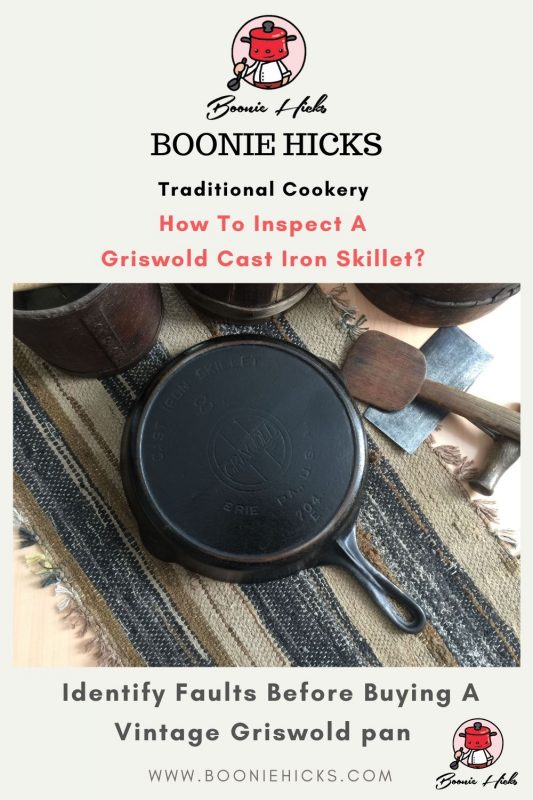
Should I Buy A rusty Griswold?
I wouldn’t overlook a skillet if it has rust, especially a Griswold. Often, you can pick up a rusty skillet at a much lower price. And you can remove the rust with some know-how. Many informative YouTube videos can give you step-by-step instructions if you want to take this route.
However, rust can hide problems even the most experienced collector cannot see. And it may cost you more money in the long run. So, it could make more sense to purchase a restored pan.
Here Are The Pros And Cons Of Purchasing A Rusty Skillet.
- Rust can hide problems such as hairline cracks.
- Rust can hide a scarce logo.
- You can often purchase a rusty skillet a lot cheaper.
- It will take time and know-how to restore a cast-iron skillet.
Carefully Inspect The Pan For Cracks.
Checking the pan for cracks is the most important thing you do before purchasing. Inspecting the pan when you can pick it up is much easier. Unfortunately, you can not check the pan if you are buying online. So, it is best practice to contact the seller and ask them if the skillet has any cracks.
Griswold Skillets Are Highly Collectible. But If It Has A Crack, I Wouldn’t Buy It. And Here’s Why.
- It may not be safe to fry food. And the pan could be a fire risk if oil dips into an electric element or gas burner.
- A hairline crack will also reduce the collectibility of the skillet.
- Hairline cracks negatively impact the value of the skillet.
Check To See Which Griswold Logo Is On The Skillet.
When you inspect a Griswold skillet, you need to recognize the logo and markings to avoid overpaying. A skillet with a large block or slant logo will cost more than a small block logo.
Some sellers may not know the difference, so it’s good for you to be aware of the different logos to avoid overpaying.
But just keep in mind a Griswold cast iron skillet with a small logo will cook just as well as one with a large block logo. And the cooking surface is just as smooth. So, if you see a Griswold skillet at a fair price, go for it.
Learn how to tell the age of a Griswold skillet by clicking the link.
Does The Pan Rock Or Wobble? Then, The Skillet Is Warped Or Bowed.
When you inspect a skillet, you want to check for movement in the pan. Often, buyers want a pan that sits completely flat, but many Griswold pans will have some rock on a flat surface.
And the seller may be open to more negotiation if the skillet is not flat. And a small rock will not affect the usability of the frypan.
However, if the pan spins on a flat surface, it could render it unusable or dangerous on the stovetop. In this case, the skillet has a downward bow and is impossible to fix without extreme measures.
Should You Buy A Griswold With Sulfur Pitting?
The indentations on the base of antique cast-iron cookware are known as pitting. Pitting is more of an issue on older pans such as early Wagner and Erie skillets. But it is not unusual to see some pitting on any vintage skillet.
Pitting does not affect the pan’s cooking performance. But again, buyers and collectors want the logo in perfect condition. A pitted skillet could allow you to purchase an excellent quality pan at a slightly lower price.
Should I Buy A Griswold Skillet With Utensil Scratches?
Often, people hear Griswold skillets are the best, but they are disappointed when they see the cooking surface. There will be some utensil scratches or pitting on most Griswold pans on the cooking surface.
After decades of use, you must expect some utensil scratches and other wear and tear. I have found this to be the case on many number 5 pans. And I think this is from owners cutting pies or cornbread while still in the pan.
Seasoning will likely fill in light utensil scratches over time. And you can remove scratches with some elbow grease. Therefore, do not expect the seller to budge too much from the initial asking price
Should I Buy A Restored Griswold Skillet?
Buying a Griswold skillet in restored condition is the most expensive way to purchase a pan. But it’s often the most practical way of buying a vintage skillet.
The restorer removes any rust and buildup from the pan and applies a fresh layer of seasoning. So you can check for any defects and faults in the skillet like the ones mentioned above. And cracks should be more visible.
Griswold skillets are excellent pans to use and collect. To learn about the best vintage cast iron skillets, click the link.
How To Inspect A Griswold Cast Iron Skillet For Faults To Reduce The Chance Of Overpaying.
I hope you have found the post helpful. And that it gives you the confidence to pick up a Griswold cast iron skillet at a market stall and inspect the pan for defects. And why sellers price their skillets differently.
Remember, there will be imperfections on most vintage skillets, and Griswold pans are no exception. Choosing a pan that feels comfortable in your hand and one that is not too small or too large to use daily is a good idea.
Most importantly, have fun looking at and buying your first piece of Griswold ironware.


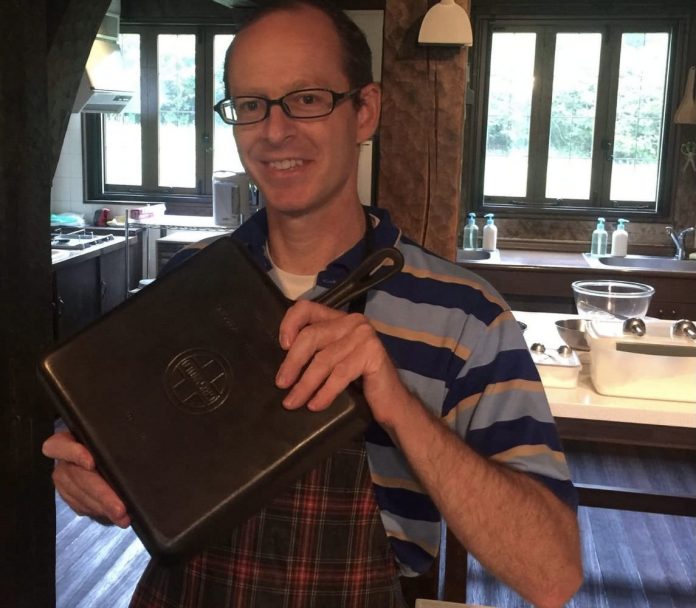
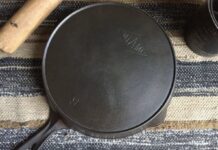
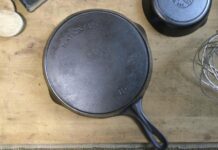
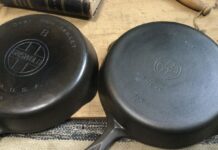



Hello, I have a Griswold dutch oven from a thrift store. I’m new to restoration so I’ve watched a few Youtube videos. After soaking a while in vinegar & water, I scrubbed with a steel wool pad. There is still some rust imbedded in the sides & bottom. I even tried using a steel brush & got a little more out.
What should I do next to get the last of the rust out? I appreciate any advice you can give me!
Becky
Hi Becky
Thanks for getting in touch. Using vinegar or baking soda are two gentle restoration methods. However, you have to let the ironware soak for a couple hours before scrubbing for best results. And often you have to repeat this process several times.
To restore a single piece of ironware; soaking and scrubbing is one of the best methods. And it makes the final results so rewarding.
Have fun